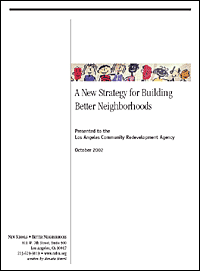What If
 A New Strategy for Building Better Neighborhoods A New Strategy for Building Better Neighborhoods
Introduction
The Los Angeles Community Redevelopment Agency (CRA) is challenged
with developing and implementing geographically based action
strategies to facilitate the social infrastructure of a community
as well as its physical and economic revitalization. However,
due to the severe nature of blight and economic disinvestments,
many project areas have not yet been able to produce sufficient
tax increment to finance CRA work programs. Additionally, in
these Los Angeles inner city communities a limited availability
of developable land, lack of adequate community infrastructure,
environmental contamination, and the regulatory approval processes
are key barriers to development.
Similarly, the CRA's current policy of exacting community facilities
through agreements with commercial developers is viewed as an
obstacle for many private investors. These existing conditions
add risk and additional cost to the development process, so much
so that it severely limits the number of private sector developers
and investors willing to pursue development in targeted communities.
Additionally, lack of available public sector resources and rules
that restrict the creativity and the risk-taking required to
engage in predevelopment activities necessary to set the stage
for private sector investment, have compounded the challenge
of neighborhood revitalization.
As a result, the CRA is often limited to pursuing small, individual
projects that become temporary band-aids for gaping redevelopment
wounds - projects like residential rehabilitation, facade improvement
and streetscape enhancements. While these strategies are important
for showing progress in project areas, they fail to leverage
extremely limited financing tools and attract the degree of economic
investment required to reverse deteriorated conditions.
Even when presented with opportunities for large-scale mixed-use
projects that may attract further private investment, the CRA
is only able to assist private developers on a site-by-site basis
and, in today's economic climate, rarely has funding to close
required project-financing gaps. This piecemeal approach to redevelopment
often results in a small deal flow and seldom achieves catalytic
neighborhood improvement. For the most part, progress in many
project areas comes to a screeching halt soon after plan adoption.
A new redevelopment model for the CRA is herein suggested. By
partnering with an "intermediary" organization to engage
in predevelopment project planning that leverages bond financing
for a variety of community infrastructure projects, the CRA can
acheive a holistic approach to redevelopment. This new model
can provide the missing link between redevelopment plan adoption
and desired private sector investment in project areas.
Holistic, or collaborative, predevelopment planning focuses on
building much needed community infrastructure projects. This
planning approach has demonstrated to other cities, like San
Diego and Glendale, that government agencies can achieve faster
and more widespread neighborhood revitalization than when they
use traditional redevelopment strategies alone. Agencies can
leverage public dollars more efficiently with a partner who manages
predevelopment work that brings together key government, business
and community organizations. This process yields individual benefits
for participants and collective gain for the entire community.
While the CRA and other City departments have staff members with
the skills to carry out portions of predevelopment activities,
they do not have the resources, time nor mandate to ensure win-win
solutions for all the parties involved. A predevelopment partner,
on the other hand, is specifically organized to execute this
role. The partner must bring a successful history of navigating
the internal culture of cities, school districts and other government
departments, attract resources to expand predevelopment activities,
and bear the initial risk inherent in managing predevelopment
activities.
Armed with this new redevelopment approach, the CRA can take
advantage of several voter-approved bond programs that are available
for community infrastructure projects. New school facilities
development, in particular, is at the heart of this strategy.
School development can eliminate economic and physical blight.
Schools play a key role in decisions by individuals and businesses
to remain or locate in a particular area. With new schools as
an anchor for collaborative land use planning, the City can amplify
redevelopment benefits by leveraging additional public funding
for neighborhood parks, police stations, libraries and pre-schools
(including early care and education). The result of this strategy
can significantly reduce the real and perceived risk for the
private sector and spur significant revitalization in CRA project
areas. Building new schools and other community amenities with
available public funding through a collaborative process can
be a linchpin to greater economic development and a tremendous
redevelopment opportunity for Los Angeles' inner city and suburban
neighborhoods.
|